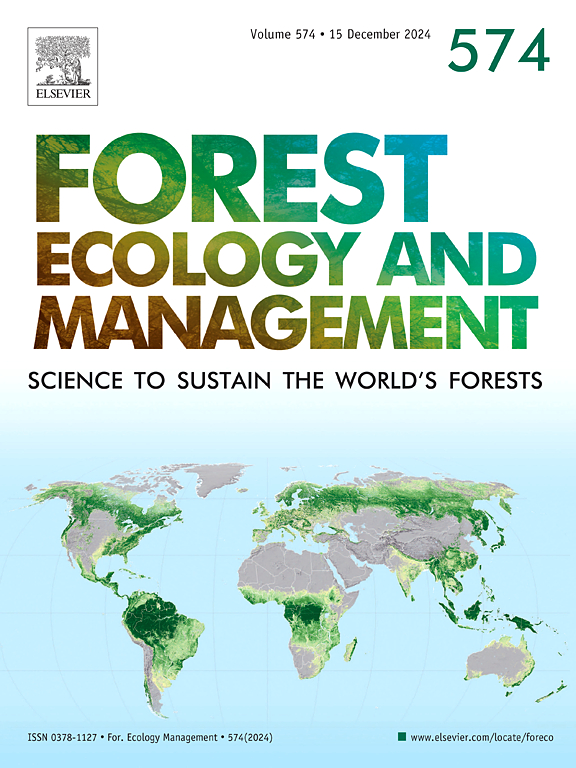整地对苏格兰松和安纳托利亚黑松纯林分早期幼苗动态和生长性能的影响
IF 3.7
2区 农林科学
Q1 FORESTRY
引用次数: 0
摘要
立地准备是用于苏格兰松和安纳托利亚黑松林分自然更新第一阶段的造林工具。这是决定再生成功与否的关键因素。造林立地的准备是一项昂贵而耗时的投资,并对环境产生各种影响。因此,了解不同的整地技术对幼苗动态和性能的影响,对于选择合适的整地技术至关重要。本研究的目的是分析和比较机械和规定的火场准备技术对早期幼苗密度、生长和存活的影响。为此,在采用林分法的再生林分上建立了试验田。在每个试验区,以机械场地准备、规定火种和火种内未燃烧面积为因素,进行了两到三个生长季节的试验。结果表明,不同的立地准备技术对苏格兰松和安纳托利亚黑松幼苗密度和成活率有影响。随着时间的推移,这些影响会根据场地条件和因素的具体动态而变化。一般情况下,规定火种地的幼苗生长发育优于机械整地。在未烧样地,幼苗在第一个生长季节的生长发育与规定的火样地相同,随后的季节与机械立地相似。我们的初步研究结果表明,规定的火可以作为自然再生的机械场地准备的替代方法。本文章由计算机程序翻译,如有差异,请以英文原文为准。
Effects of site preparation on early stage seedling dynamics and performance in pure Scots pine and Anatolian black pine stands
Site preparation is a silvicultural tool used in the first stage of natural regeneration for Scots pine and Anatolian black pine stands. It is a key factor in determining the success of regeneration. Silvicultural site preparation is an expensive and time-consuming investment with various environmental impacts. Therefore, understanding the effects of different site preparation techniques on seedling dynamics and performance is essential for selecting the proper technique. The objective of this study was to analyze and compare the effects of mechanical and prescribed fire site preparation techniques on early stage seedling density, growth, and survival. To investigate, experimental plots were established in regeneration stands where the shelterwood method was applied. In each experimental plot, mechanical site preparation, prescribed fire, and unburned areas within fire plots were tested as factors over two or three growing seasons. The results of this study indicated that different site preparation techniques affected Scots pine and Anatolian black pine seedling density and survival. These effects changed over time according to the site conditions and the specific dynamics of the factors. Generally, seedlings in the prescribed fire plots showed better growth and development than those in the mechanical site preparation plots. In the unburned plots, seedlings showed growth and development identical to those in the prescribed fire plots during the first growing season and similar to those in the mechanical site preparation plots in subsequent seasons. Our preliminary findings indicate that prescribed fire can be used as an alternative to mechanical site preparation for natural regeneration.
求助全文
通过发布文献求助,成功后即可免费获取论文全文。
去求助
来源期刊

Forest Ecology and Management
农林科学-林学
CiteScore
7.50
自引率
10.80%
发文量
665
审稿时长
39 days
期刊介绍:
Forest Ecology and Management publishes scientific articles linking forest ecology with forest management, focusing on the application of biological, ecological and social knowledge to the management and conservation of plantations and natural forests. The scope of the journal includes all forest ecosystems of the world.
A peer-review process ensures the quality and international interest of the manuscripts accepted for publication. The journal encourages communication between scientists in disparate fields who share a common interest in ecology and forest management, bridging the gap between research workers and forest managers.
We encourage submission of papers that will have the strongest interest and value to the Journal''s international readership. Some key features of papers with strong interest include:
1. Clear connections between the ecology and management of forests;
2. Novel ideas or approaches to important challenges in forest ecology and management;
3. Studies that address a population of interest beyond the scale of single research sites, Three key points in the design of forest experiments, Forest Ecology and Management 255 (2008) 2022-2023);
4. Review Articles on timely, important topics. Authors are welcome to contact one of the editors to discuss the suitability of a potential review manuscript.
The Journal encourages proposals for special issues examining important areas of forest ecology and management. Potential guest editors should contact any of the Editors to begin discussions about topics, potential papers, and other details.
 求助内容:
求助内容: 应助结果提醒方式:
应助结果提醒方式:


